wheel CHEVROLET TAHOE 2007 3.G Manual PDF
[x] Cancel search | Manufacturer: CHEVROLET, Model Year: 2007, Model line: TAHOE, Model: CHEVROLET TAHOE 2007 3.GPages: 634, PDF Size: 3.18 MB
Page 419 of 634
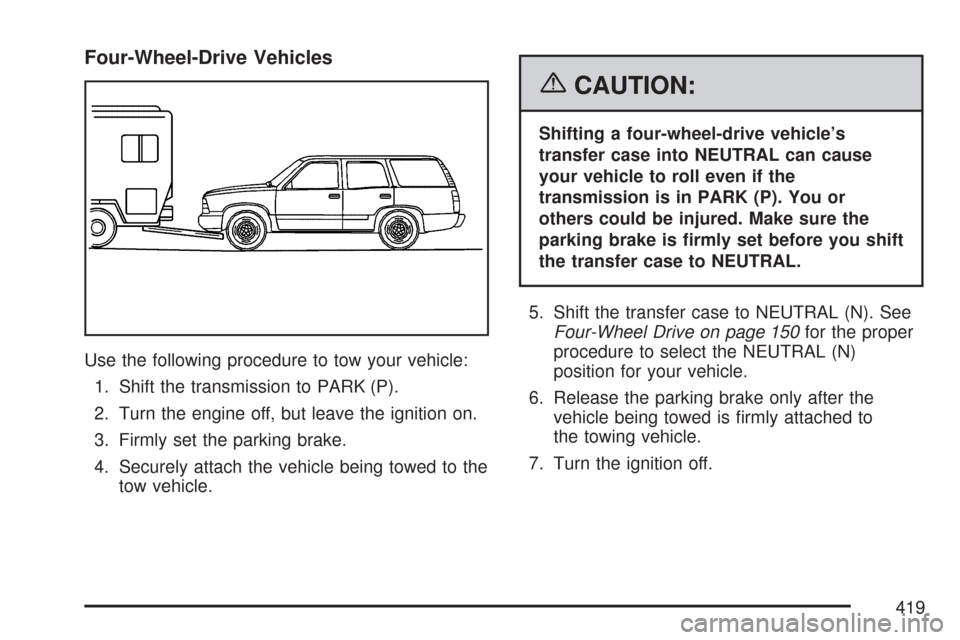
Four-Wheel-Drive Vehicles
Use the following procedure to tow your vehicle:
1. Shift the transmission to PARK (P).
2. Turn the engine off, but leave the ignition on.
3. Firmly set the parking brake.
4. Securely attach the vehicle being towed to the
tow vehicle.
{CAUTION:
Shifting a four-wheel-drive vehicle’s
transfer case into NEUTRAL can cause
your vehicle to roll even if the
transmission is in PARK (P). You or
others could be injured. Make sure the
parking brake is �rmly set before you shift
the transfer case to NEUTRAL.
5. Shift the transfer case to NEUTRAL (N). See
Four-Wheel Drive on page 150for the proper
procedure to select the NEUTRAL (N)
position for your vehicle.
6. Release the parking brake only after the
vehicle being towed is �rmly attached to
the towing vehicle.
7. Turn the ignition off.
419
Page 420 of 634
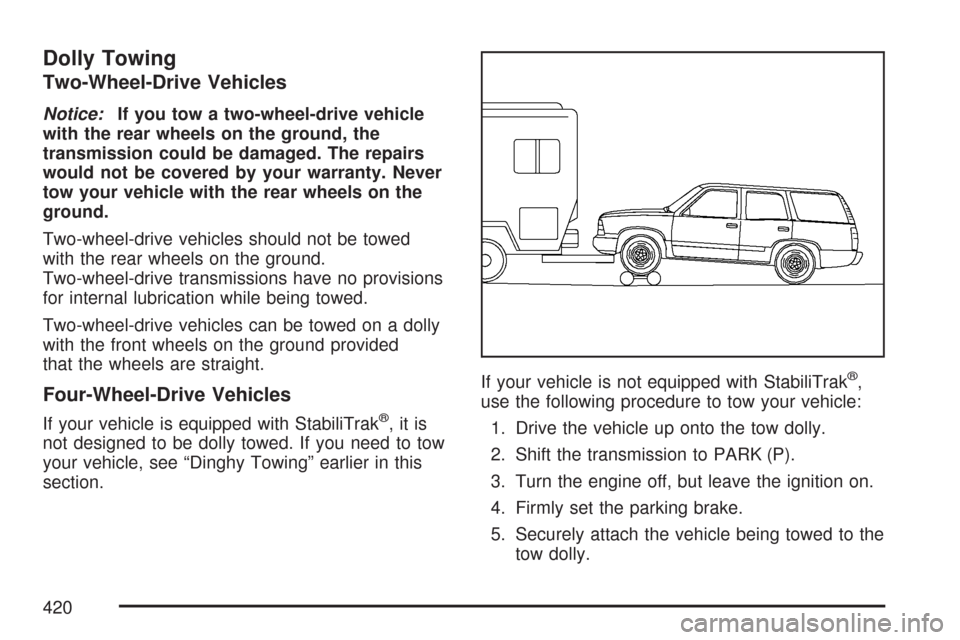
Dolly Towing
Two-Wheel-Drive Vehicles
Notice:If you tow a two-wheel-drive vehicle
with the rear wheels on the ground, the
transmission could be damaged. The repairs
would not be covered by your warranty. Never
tow your vehicle with the rear wheels on the
ground.
Two-wheel-drive vehicles should not be towed
with the rear wheels on the ground.
Two-wheel-drive transmissions have no provisions
for internal lubrication while being towed.
Two-wheel-drive vehicles can be towed on a dolly
with the front wheels on the ground provided
that the wheels are straight.
Four-Wheel-Drive Vehicles
If your vehicle is equipped with StabiliTrak®,itis
not designed to be dolly towed. If you need to tow
your vehicle, see “Dinghy Towing” earlier in this
section.If your vehicle is not equipped with StabiliTrak
®,
use the following procedure to tow your vehicle:
1. Drive the vehicle up onto the tow dolly.
2. Shift the transmission to PARK (P).
3. Turn the engine off, but leave the ignition on.
4. Firmly set the parking brake.
5. Securely attach the vehicle being towed to the
tow dolly.
420
Page 421 of 634
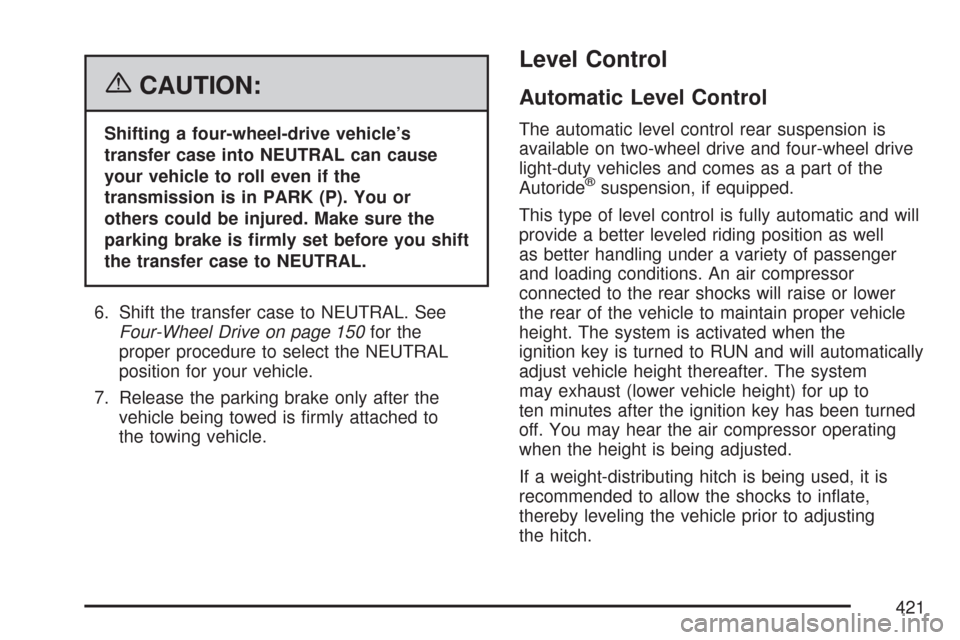
{CAUTION:
Shifting a four-wheel-drive vehicle’s
transfer case into NEUTRAL can cause
your vehicle to roll even if the
transmission is in PARK (P). You or
others could be injured. Make sure the
parking brake is �rmly set before you shift
the transfer case to NEUTRAL.
6. Shift the transfer case to NEUTRAL. See
Four-Wheel Drive on page 150for the
proper procedure to select the NEUTRAL
position for your vehicle.
7. Release the parking brake only after the
vehicle being towed is �rmly attached to
the towing vehicle.
Level Control
Automatic Level Control
The automatic level control rear suspension is
available on two-wheel drive and four-wheel drive
light-duty vehicles and comes as a part of the
Autoride
®suspension, if equipped.
This type of level control is fully automatic and will
provide a better leveled riding position as well
as better handling under a variety of passenger
and loading conditions. An air compressor
connected to the rear shocks will raise or lower
the rear of the vehicle to maintain proper vehicle
height. The system is activated when the
ignition key is turned to RUN and will automatically
adjust vehicle height thereafter. The system
may exhaust (lower vehicle height) for up to
ten minutes after the ignition key has been turned
off. You may hear the air compressor operating
when the height is being adjusted.
If a weight-distributing hitch is being used, it is
recommended to allow the shocks to in�ate,
thereby leveling the vehicle prior to adjusting
the hitch.
421
Page 422 of 634
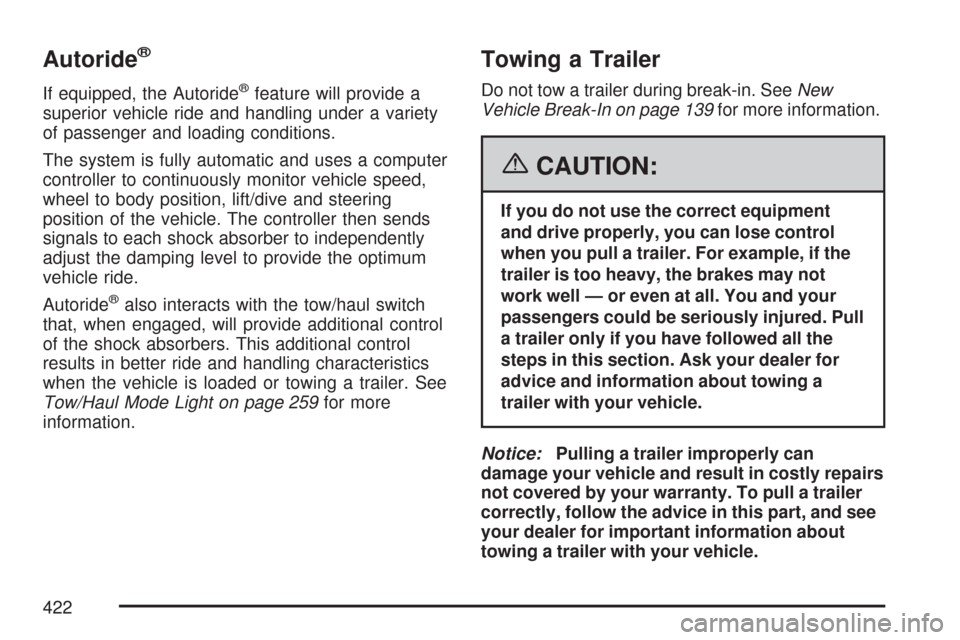
Autoride®
If equipped, the Autoride®feature will provide a
superior vehicle ride and handling under a variety
of passenger and loading conditions.
The system is fully automatic and uses a computer
controller to continuously monitor vehicle speed,
wheel to body position, lift/dive and steering
position of the vehicle. The controller then sends
signals to each shock absorber to independently
adjust the damping level to provide the optimum
vehicle ride.
Autoride
®also interacts with the tow/haul switch
that, when engaged, will provide additional control
of the shock absorbers. This additional control
results in better ride and handling characteristics
when the vehicle is loaded or towing a trailer. See
Tow/Haul Mode Light on page 259for more
information.
Towing a Trailer
Do not tow a trailer during break-in. SeeNew
Vehicle Break-In on page 139for more information.
{CAUTION:
If you do not use the correct equipment
and drive properly, you can lose control
when you pull a trailer. For example, if the
trailer is too heavy, the brakes may not
work well — or even at all. You and your
passengers could be seriously injured. Pull
a trailer only if you have followed all the
steps in this section. Ask your dealer for
advice and information about towing a
trailer with your vehicle.
Notice:Pulling a trailer improperly can
damage your vehicle and result in costly repairs
not covered by your warranty. To pull a trailer
correctly, follow the advice in this part, and see
your dealer for important information about
towing a trailer with your vehicle.
422
Page 434 of 634
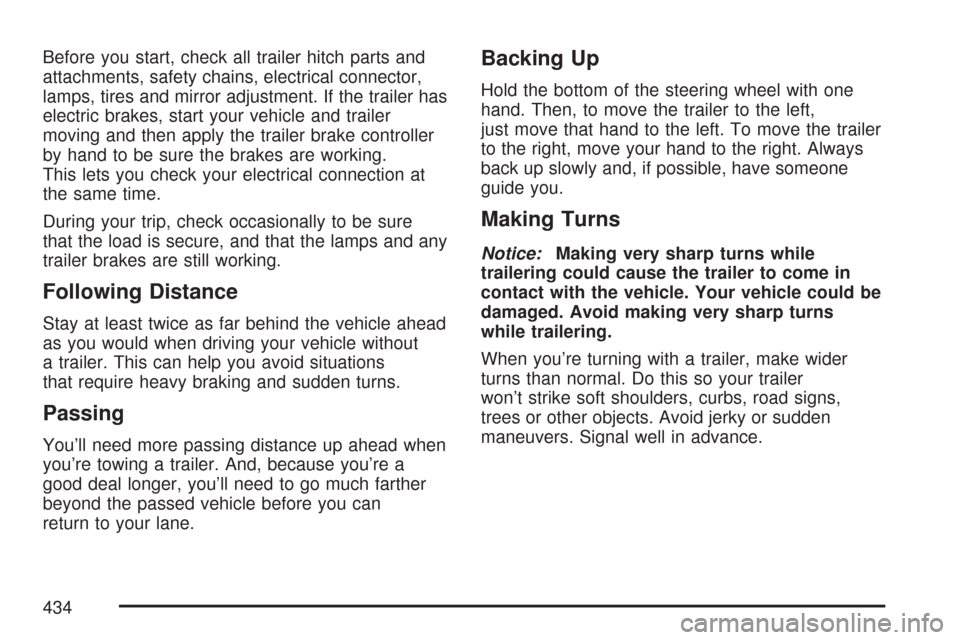
Before you start, check all trailer hitch parts and
attachments, safety chains, electrical connector,
lamps, tires and mirror adjustment. If the trailer has
electric brakes, start your vehicle and trailer
moving and then apply the trailer brake controller
by hand to be sure the brakes are working.
This lets you check your electrical connection at
the same time.
During your trip, check occasionally to be sure
that the load is secure, and that the lamps and any
trailer brakes are still working.
Following Distance
Stay at least twice as far behind the vehicle ahead
as you would when driving your vehicle without
a trailer. This can help you avoid situations
that require heavy braking and sudden turns.
Passing
You’ll need more passing distance up ahead when
you’re towing a trailer. And, because you’re a
good deal longer, you’ll need to go much farther
beyond the passed vehicle before you can
return to your lane.
Backing Up
Hold the bottom of the steering wheel with one
hand. Then, to move the trailer to the left,
just move that hand to the left. To move the trailer
to the right, move your hand to the right. Always
back up slowly and, if possible, have someone
guide you.
Making Turns
Notice:Making very sharp turns while
trailering could cause the trailer to come in
contact with the vehicle. Your vehicle could be
damaged. Avoid making very sharp turns
while trailering.
When you’re turning with a trailer, make wider
turns than normal. Do this so your trailer
won’t strike soft shoulders, curbs, road signs,
trees or other objects. Avoid jerky or sudden
maneuvers. Signal well in advance.
434
Page 436 of 634
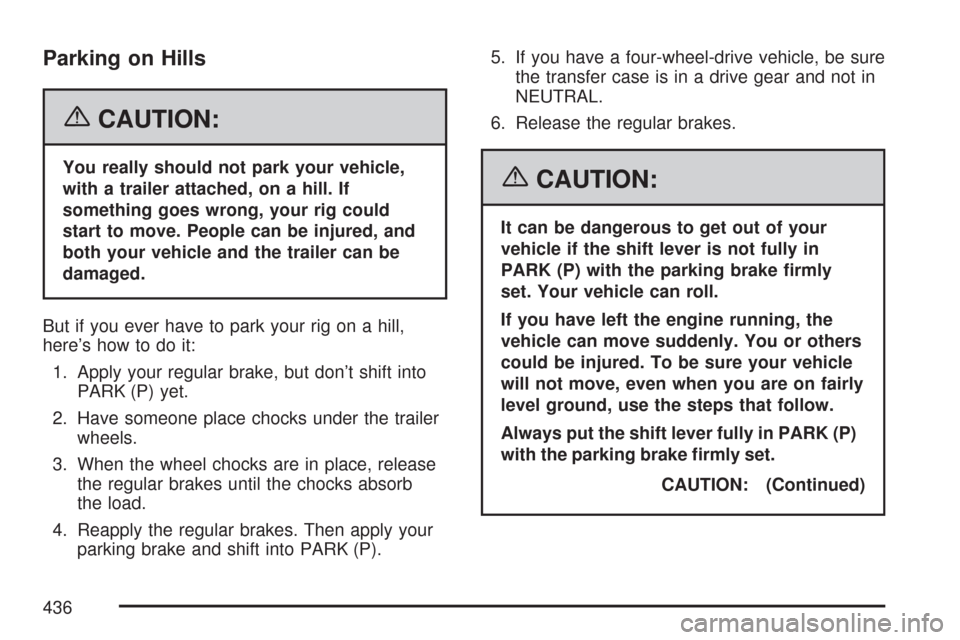
Parking on Hills
{CAUTION:
You really should not park your vehicle,
with a trailer attached, on a hill. If
something goes wrong, your rig could
start to move. People can be injured, and
both your vehicle and the trailer can be
damaged.
But if you ever have to park your rig on a hill,
here’s how to do it:
1. Apply your regular brake, but don’t shift into
PARK (P) yet.
2. Have someone place chocks under the trailer
wheels.
3. When the wheel chocks are in place, release
the regular brakes until the chocks absorb
the load.
4. Reapply the regular brakes. Then apply your
parking brake and shift into PARK (P).5. If you have a four-wheel-drive vehicle, be sure
the transfer case is in a drive gear and not in
NEUTRAL.
6. Release the regular brakes.{CAUTION:
It can be dangerous to get out of your
vehicle if the shift lever is not fully in
PARK (P) with the parking brake �rmly
set. Your vehicle can roll.
If you have left the engine running, the
vehicle can move suddenly. You or others
could be injured. To be sure your vehicle
will not move, even when you are on fairly
level ground, use the steps that follow.
Always put the shift lever fully in PARK (P)
with the parking brake �rmly set.
CAUTION: (Continued)
436
Page 437 of 634
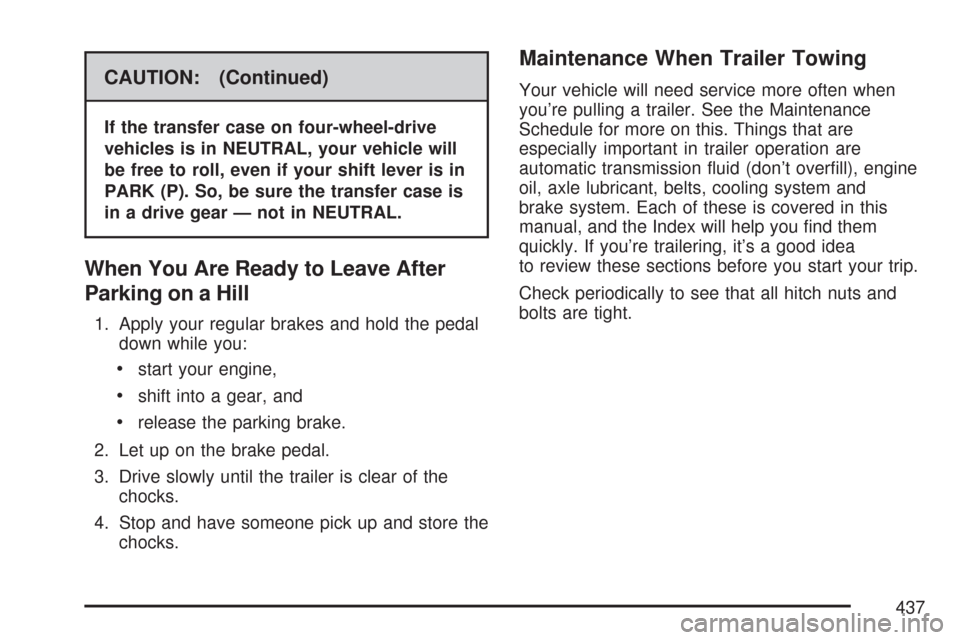
CAUTION: (Continued)
If the transfer case on four-wheel-drive
vehicles is in NEUTRAL, your vehicle will
be free to roll, even if your shift lever is in
PARK (P). So, be sure the transfer case is
in a drive gear — not in NEUTRAL.
When You Are Ready to Leave After
Parking on a Hill
1. Apply your regular brakes and hold the pedal
down while you:
start your engine,
shift into a gear, and
release the parking brake.
2. Let up on the brake pedal.
3. Drive slowly until the trailer is clear of the
chocks.
4. Stop and have someone pick up and store the
chocks.
Maintenance When Trailer Towing
Your vehicle will need service more often when
you’re pulling a trailer. See the Maintenance
Schedule for more on this. Things that are
especially important in trailer operation are
automatic transmission �uid (don’t over�ll), engine
oil, axle lubricant, belts, cooling system and
brake system. Each of these is covered in this
manual, and the Index will help you �nd them
quickly. If you’re trailering, it’s a good idea
to review these sections before you start your trip.
Check periodically to see that all hitch nuts and
bolts are tight.
437
Page 441 of 634
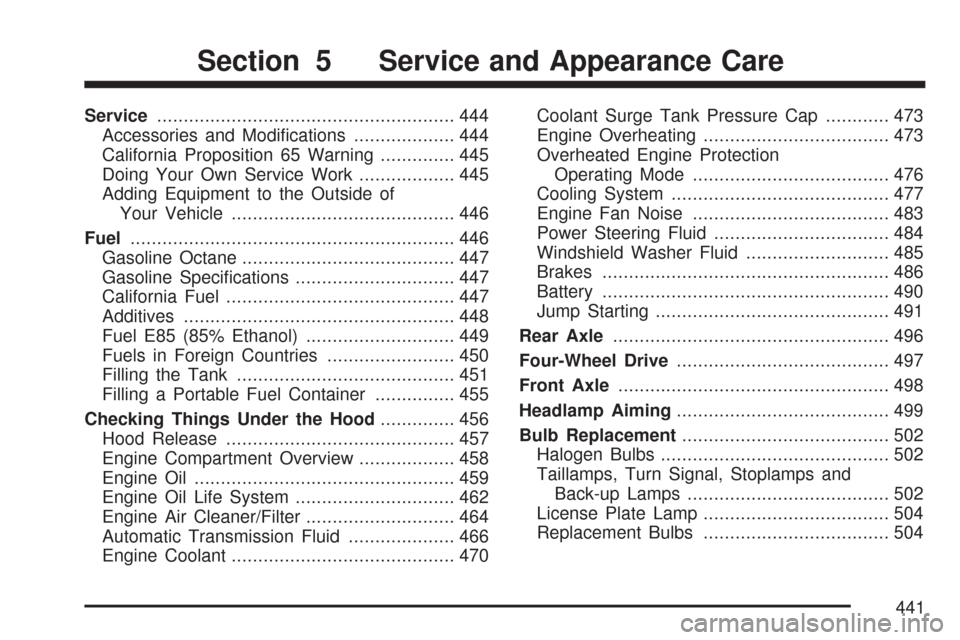
Service........................................................ 444
Accessories and Modi�cations................... 444
California Proposition 65 Warning.............. 445
Doing Your Own Service Work.................. 445
Adding Equipment to the Outside of
Your Vehicle.......................................... 446
Fuel............................................................. 446
Gasoline Octane........................................ 447
Gasoline Speci�cations.............................. 447
California Fuel........................................... 447
Additives................................................... 448
Fuel E85 (85% Ethanol)............................ 449
Fuels in Foreign Countries........................ 450
Filling the Tank......................................... 451
Filling a Portable Fuel Container............... 455
Checking Things Under the Hood.............. 456
Hood Release........................................... 457
Engine Compartment Overview.................. 458
Engine Oil................................................. 459
Engine Oil Life System.............................. 462
Engine Air Cleaner/Filter............................ 464
Automatic Transmission Fluid.................... 466
Engine Coolant.......................................... 470Coolant Surge Tank Pressure Cap............ 473
Engine Overheating................................... 473
Overheated Engine Protection
Operating Mode..................................... 476
Cooling System......................................... 477
Engine Fan Noise..................................... 483
Power Steering Fluid ................................. 484
Windshield Washer Fluid........................... 485
Brakes...................................................... 486
Battery...................................................... 490
Jump Starting............................................ 491
Rear Axle.................................................... 496
Four-Wheel Drive........................................ 497
Front Axle................................................... 498
Headlamp Aiming........................................ 499
Bulb Replacement....................................... 502
Halogen Bulbs........................................... 502
Taillamps, Turn Signal, Stoplamps and
Back-up Lamps...................................... 502
License Plate Lamp................................... 504
Replacement Bulbs................................... 504
Section 5 Service and Appearance Care
441
Page 442 of 634
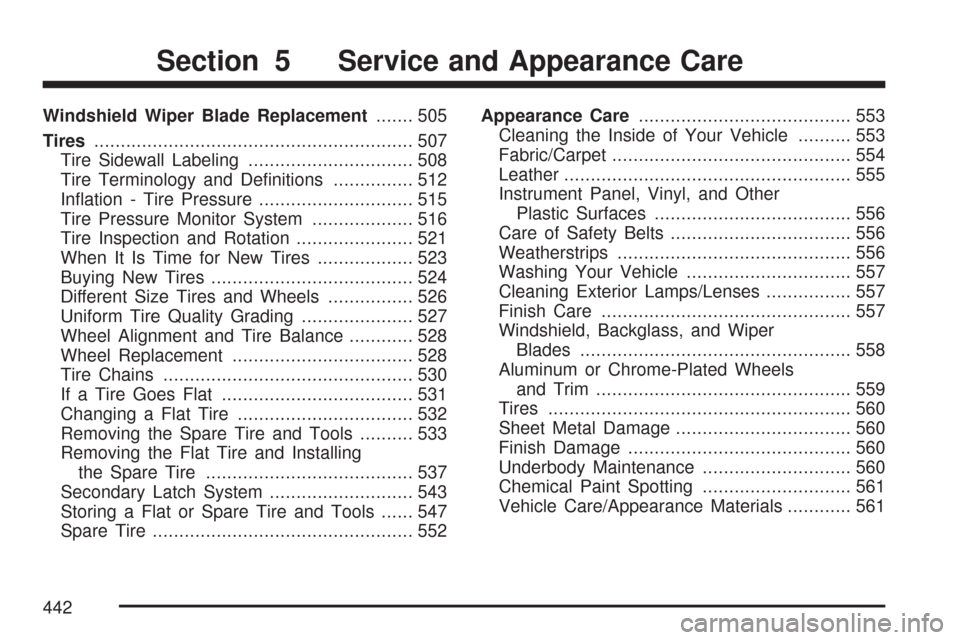
Windshield Wiper Blade Replacement....... 505
Tires............................................................ 507
Tire Sidewall Labeling............................... 508
Tire Terminology and De�nitions............... 512
In�ation - Tire Pressure............................. 515
Tire Pressure Monitor System................... 516
Tire Inspection and Rotation...................... 521
When It Is Time for New Tires.................. 523
Buying New Tires...................................... 524
Different Size Tires and Wheels................ 526
Uniform Tire Quality Grading..................... 527
Wheel Alignment and Tire Balance............ 528
Wheel Replacement.................................. 528
Tire Chains............................................... 530
If a Tire Goes Flat.................................... 531
Changing a Flat Tire................................. 532
Removing the Spare Tire and Tools.......... 533
Removing the Flat Tire and Installing
the Spare Tire....................................... 537
Secondary Latch System........................... 543
Storing a Flat or Spare Tire and Tools...... 547
Spare Tire................................................. 552Appearance Care........................................ 553
Cleaning the Inside of Your Vehicle.......... 553
Fabric/Carpet............................................. 554
Leather...................................................... 555
Instrument Panel, Vinyl, and Other
Plastic Surfaces..................................... 556
Care of Safety Belts.................................. 556
Weatherstrips............................................ 556
Washing Your Vehicle............................... 557
Cleaning Exterior Lamps/Lenses................ 557
Finish Care............................................... 557
Windshield, Backglass, and Wiper
Blades................................................... 558
Aluminum or Chrome-Plated Wheels
and Trim................................................ 559
Tires......................................................... 560
Sheet Metal Damage................................. 560
Finish Damage.......................................... 560
Underbody Maintenance............................ 560
Chemical Paint Spotting............................ 561
Vehicle Care/Appearance Materials............ 561
Section 5 Service and Appearance Care
442
Page 457 of 634
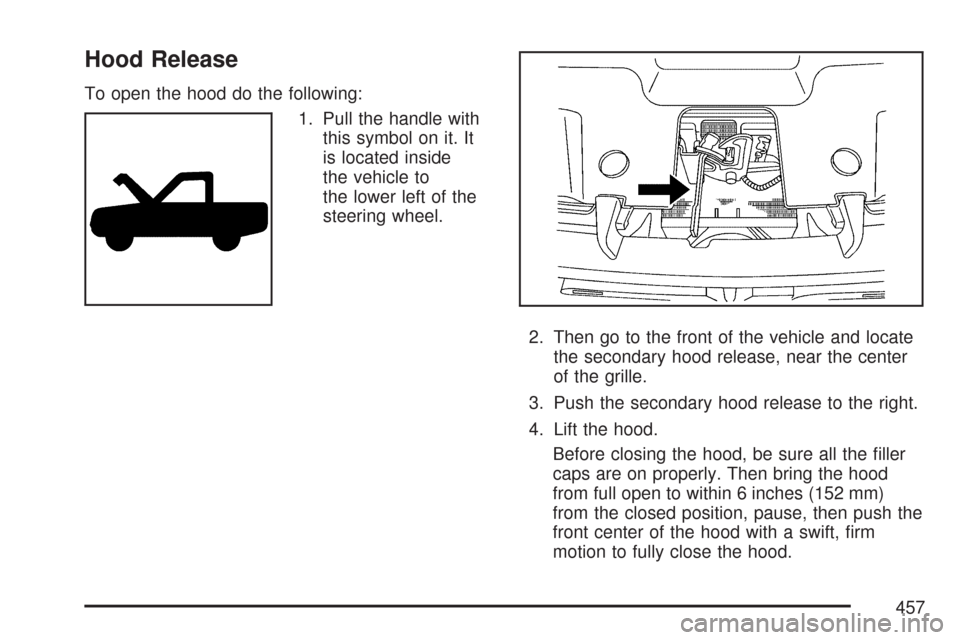
Hood Release
To open the hood do the following:
1. Pull the handle with
this symbol on it. It
is located inside
the vehicle to
the lower left of the
steering wheel.
2. Then go to the front of the vehicle and locate
the secondary hood release, near the center
of the grille.
3. Push the secondary hood release to the right.
4. Lift the hood.
Before closing the hood, be sure all the �ller
caps are on properly. Then bring the hood
from full open to within 6 inches (152 mm)
from the closed position, pause, then push the
front center of the hood with a swift, �rm
motion to fully close the hood.
457